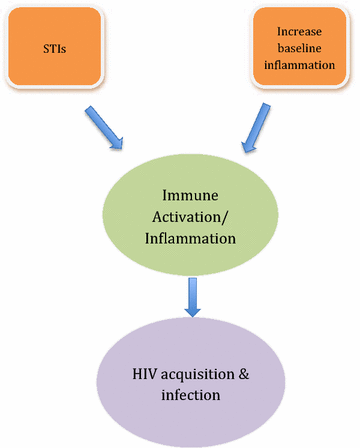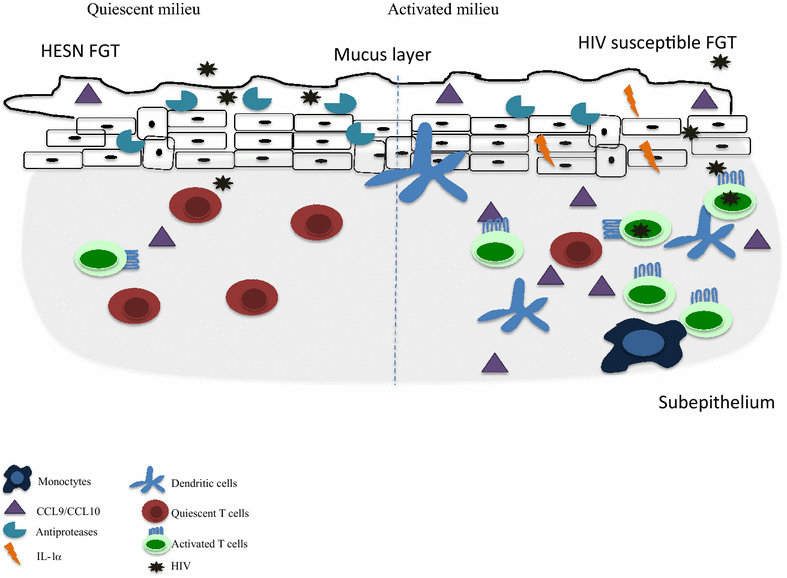Preventing HIV infection without targeting the virus: how reducing HIV target cells at the genital tract is a new approach to HIV prevention
- PMID: 28893304
- PMCID: PMC5594430
- DOI: 10.1186/s12981-017-0166-7
Preventing HIV infection without targeting the virus: how reducing HIV target cells at the genital tract is a new approach to HIV prevention
Abstract
For over three decades, HIV infection has had a tremendous impact on the lives of individuals and public health. Microbicides and vaccines studies have shown that immune activation at the genital tract is a risk factor for HIV infection. Furthermore, lower level of immune activation, or what we call immune quiescence, has been associated with a lower risk of HIV acquisition. This unique phenotype is observed in highly-exposed seronegative individuals from different populations including female sex workers from the Pumwani cohort in Nairobi, Kenya. Here, we review the link between immune activation and susceptibility to HIV infection. We also describe a new concept in prevention where, instead of targeting the virus, we modulate the host immune system to resist HIV infection. Mimicking the immune quiescence phenotype might become a new strategy in the toolbox of biomedical methods to prevent HIV infection. Clinical trial registration on clinicaltrial.gov: #NCT02079077.
Keywords: HIV; Highly exposed seronegative (HESN); Immune activation; Immune quiescence; Protection.
Figures


Similar articles
-
Using safe, affordable and accessible non-steroidal anti-inflammatory drugs to reduce the number of HIV target cells in the blood and at the female genital tract.J Int AIDS Soc. 2018 Jul;21(7):e25150. doi: 10.1002/jia2.25150. J Int AIDS Soc. 2018. PMID: 30047573 Free PMC article. Clinical Trial.
-
Mucosal immune responses in the genital tract of HIV-1-exposed uninfected women.J Intern Med. 2007 Jul;262(1):44-58. doi: 10.1111/j.1365-2796.2007.01822.x. J Intern Med. 2007. PMID: 17598814 Review.
-
Mx2 expression is associated with reduced susceptibility to HIV infection in highly exposed HIV seronegative Kenyan sex workers.AIDS. 2015 Jan 2;29(1):35-41. doi: 10.1097/QAD.0000000000000490. AIDS. 2015. PMID: 25562491
-
A distinct cytokine and chemokine profile at the genital mucosa is associated with HIV-1 protection among HIV-exposed seronegative commercial sex workers.Mucosal Immunol. 2012 May;5(3):277-87. doi: 10.1038/mi.2012.7. Epub 2012 Feb 8. Mucosal Immunol. 2012. PMID: 22318497
-
Mucosal correlates of protection in HIV-1-exposed sero-negative persons.Am J Reprod Immunol. 2014 Aug;72(2):219-27. doi: 10.1111/aji.12202. Epub 2014 Jan 16. Am J Reprod Immunol. 2014. PMID: 24428610 Free PMC article. Review.
Cited by
-
Tackling the cytokine storm in COVID-19, challenges and hopes.Life Sci. 2020 Sep 15;257:118054. doi: 10.1016/j.lfs.2020.118054. Epub 2020 Jul 11. Life Sci. 2020. PMID: 32663575 Free PMC article. Review.
-
HIV vaccine research in Canada.AIDS Res Ther. 2017 Sep 12;14(1):54. doi: 10.1186/s12981-017-0181-8. AIDS Res Ther. 2017. PMID: 28893293 Free PMC article. No abstract available.
-
Middle East Respiratory Syndrome (MERS) and novel coronavirus disease-2019 (COVID-19): From causes to preventions in Saudi Arabia.Saudi Pharm J. 2020 Nov;28(11):1481-1491. doi: 10.1016/j.jsps.2020.09.014. Epub 2020 Sep 24. Saudi Pharm J. 2020. PMID: 32994704 Free PMC article. Review.
-
Impact of chronic sexual abuse and depression on inflammation and wound healing in the female reproductive tract of HIV-uninfected and HIV-infected women.PLoS One. 2018 Jun 12;13(6):e0198412. doi: 10.1371/journal.pone.0198412. eCollection 2018. PLoS One. 2018. PMID: 29894487 Free PMC article.
-
The Pre-clinical Toolbox of Pharmacokinetics and Pharmacodynamics: in vitro and ex vivo Models.Front Pharmacol. 2019 May 24;10:578. doi: 10.3389/fphar.2019.00578. eCollection 2019. Front Pharmacol. 2019. PMID: 31178736 Free PMC article. Review.
References
-
- UNAIDS. Global aids up date 2016; 2016. p. 1–16.
-
- Plummer FA. Heterosexual transmission of human immunodeficiency virus type 1 (HIV): interactions of conventional sexually transmitted diseases, hormonal contraception and HIV-1. AIDS Res Hum Retrovir. 1998;14(Suppl 1):S5–S10. - PubMed
Publication types
MeSH terms
Substances
Associated data
LinkOut - more resources
Full Text Sources
Other Literature Sources
Medical
Miscellaneous

